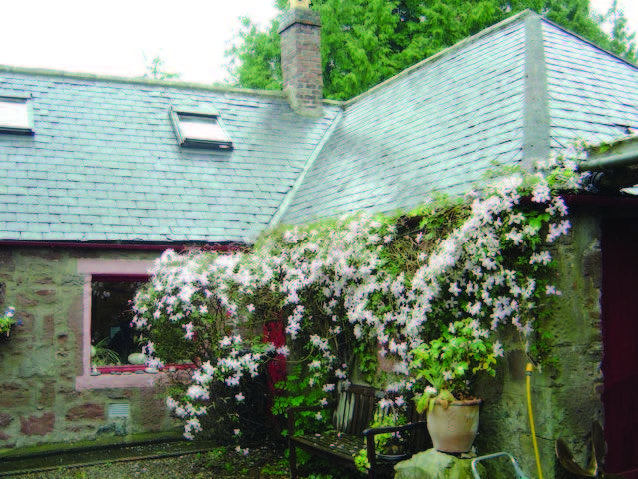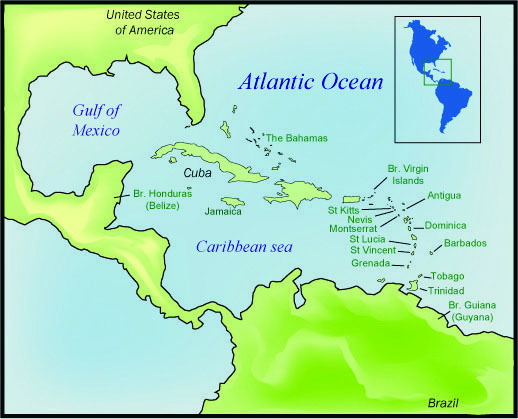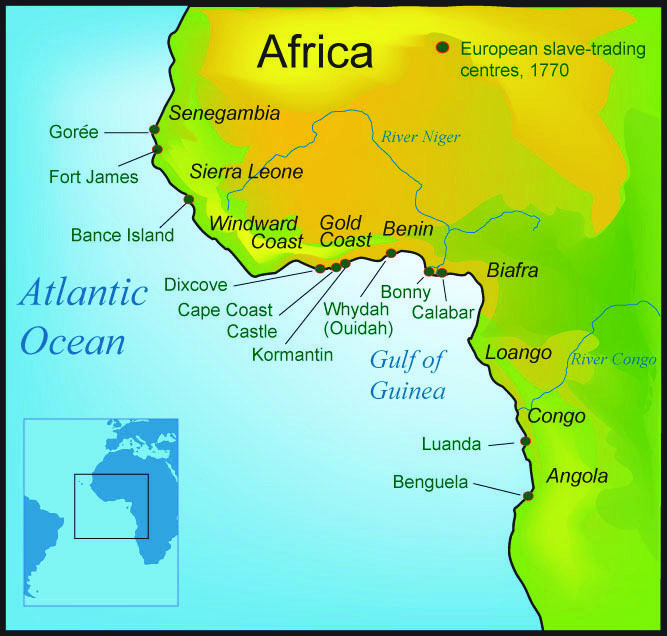Abolishing the slave trade

In 1807, after a 20-year fight by British and African activists, Britain finally banned the slave trade. Slavery was still permitted in British territories, but plantation owners could no longer enslave and deport people from Africa.
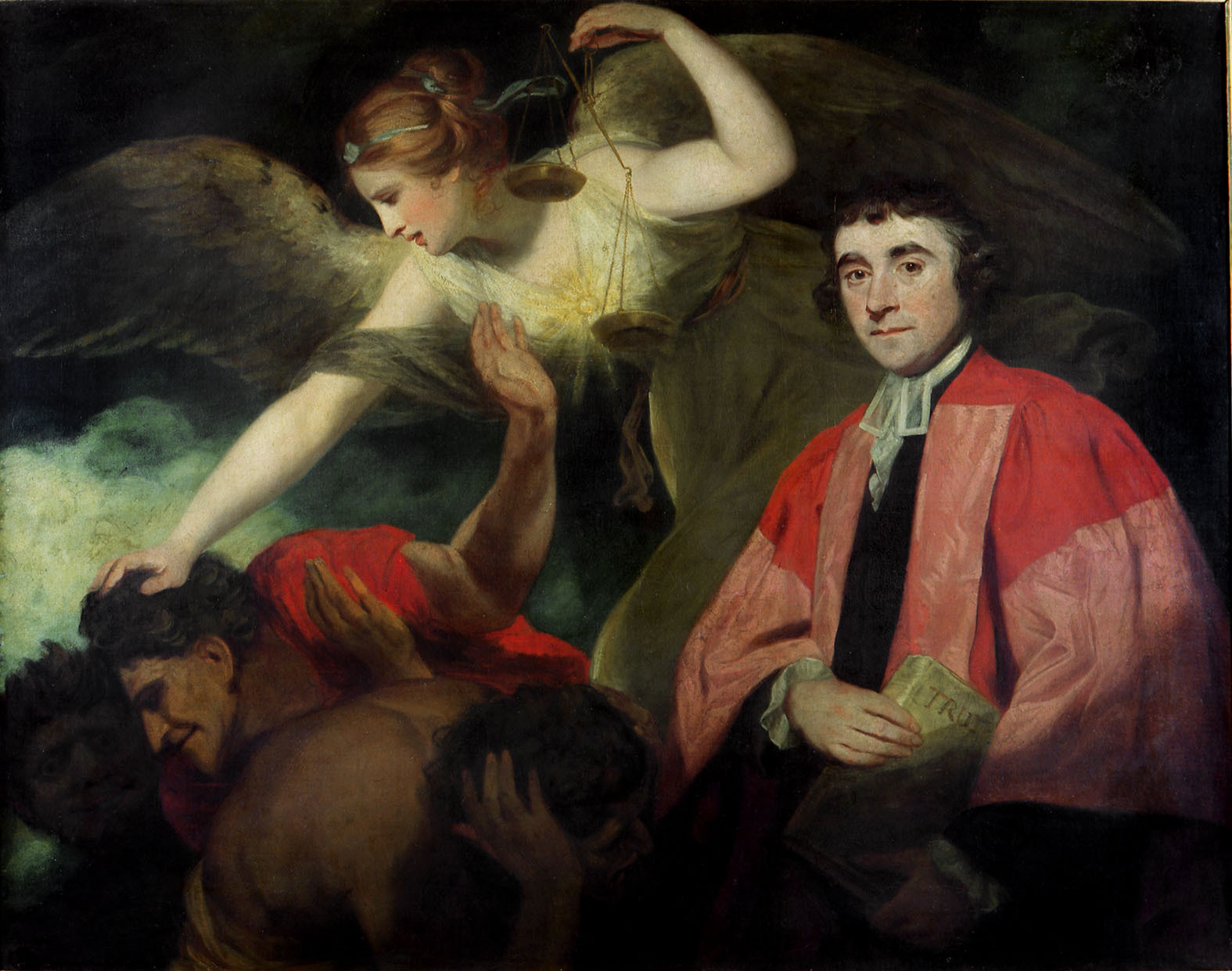
Dr James Beattie defeats the ‘enemies of Truth’, by Joshua Reynolds, 1773.
(© The University of Aberdeen)
Many North East Scots joined the fight to abolish the slave trade. In 1770 Dr James Beattie, a philosopher at Marischal College, became one of the first public figures to argue that slavery was morally wrong. Thinkers such as Adam Smith had criticised the economics of slavery, but Beattie condemned it for treating Africans as less than human.
Tortures, murder, and every other imaginable barbarity and iniquity are practised upon the poor slaves with impunity. I hope the slave-trade will be abolished. I pray it may be an event at hand.
Olaudah Equiano calls for the abolition of slavery, 1789
Beattie’s friend, the Reverend James Ramsay of Fraserburgh, was another influential voice against slavery. In 1784, after years working in St Kitts, he detailed the horrors of plantation slavery in An Essay on the Treatment and Conversion of African Slaves. The book helped persuade abolitionists such as Thomas Clarkson and William Wilberforce to launch a public campaign against the slave trade.
In 1792 the Scottish Quaker William Dickson took this campaign to North East Scotland. He found eager audiences in towns such as Fordyce, Huntly and Turriff. Other places, including Alford, Stonehaven and Banff, sent petitions to parliament opposing the trade.
Perhaps the most influential abolitionist to visit the North East was the formerly enslaved man Olaudah Equiano. He called at Aberdeen on 23 August 1792 to publicise his autobiography. This told how he had been kidnapped as a child from Nigeria and sold into slavery in America. Reading this was a dramatic experience for his Scottish audience. It helped them realise the truth of Beattie’s teaching – that Africans were human just like them.
We buy and enslave them, not because we have had proof of their wickedness, but because they are black, and have been brought from Africa.
James Beattie lectures against slavery at Marischal College, 1797
James Beattie
James Beattie (1735–1803) was born in Laurencekirk, the son of a shopkeeper.
He won a bursary to Marischal College when he was 14. After graduating he became a schoolmaster, continuing to study and to publish poetry in his spare time. In about 1760 he was appointed professor of Moral Philosophy at Marischal College, where he remained for the rest of his life. He is mostly remembered today as a minor philosopher and Romantic poet.
In 1770 he published An Essay on the Nature and Immutability of Truth, which attacked the work of the most famous philosopher of the day, David Hume. Beattie particularly criticised Hume for his description of Africans as an inferior people who had been enslaved because they lacked civilisation and ingenuity. The Essay made Beattie a famous man, and prompted Sir Joshua Reynolds to paint a flattering portrait of him defeating the ‘enemies of Truth’.
Beattie included another, more forceful denunciation of slavery in his next big philosophical work, Elements of Moral Science (1790–3). Despite the pleadings of anti-slave trade campaigners, however, he declined to publish any of his anti-slavery arguments in short pamphlets – the type of publication that would have been most useful to a mass campaign. It is unclear why he was reluctant to do this. He himself argued that his most useful anti-slavery work was done in the classroom where he lectured generations of Marischal College students on the moral evils of slavery.
James Ramsay
James Ramsay (1733–1789) was born in Fraserburgh and educated at King’s College, Aberdeen.
After his first career as a naval surgeon was cut short by injury, he studied divinity and became an Anglican priest on the Caribbean island of St Kitts (St Christopher).
At St Kitts, Ramsay welcomed enslaved Africans into his church and encouraged them to convert to Christianity. He also publicly criticised the plantation owners’ maltreatment and abuse of enslaved people. The slavers responded by conducting a public campaign against Ramsay, eventually forcing him to leave the island.
In 1781 Sir Charles Middleton, another opponent of slavery who knew Ramsay from his early naval career, invited Ramsay to become the rector at the parish church of Teston in Kent. Ramsay settled there for the rest of his life, along with Nestor, an African servant whom he had brought with him from St Kitts.
At Teston, Ramsay immediately began writing his Essay on the Treatment and Conversion of African Slaves in the British Sugar Colonies (1784). This had a dramatic impact on the public debate about slavery. As an Anglican priest, Ramsay’s arguments were respected, and he also presented a mass of original, eye-witness accounts which were hard to discredit. Once again, however, he was attacked and ridiculed by the slavers and their supporters.

A plaque commemorating James Ramsay in St Peter's Scottish Episcopal Church at Fraserburgh. © Robert Henderson
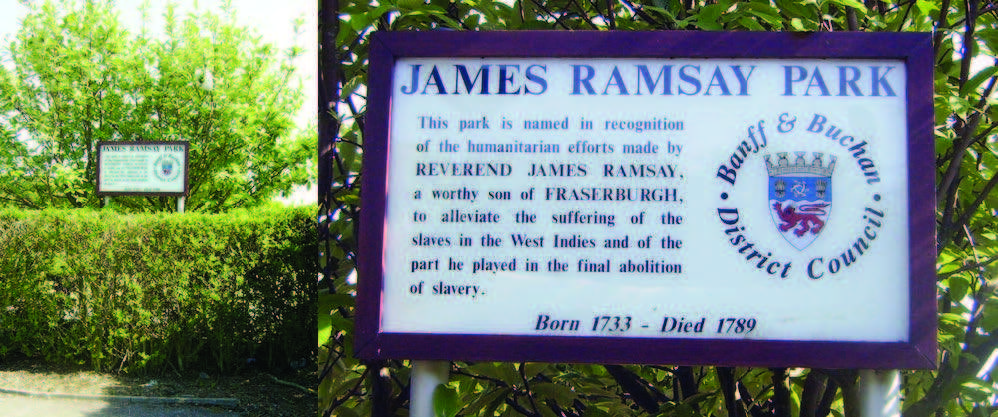
James Ramsay Park at Fraserburgh. © Robert Henderson.
Although Ramsay hated slavery, he did not believe that it was politically possible to end it at once. Like many other campaigners, he argued that it was necessary first to stop the slave trade and thus to cut off the supply of newly enslaved people to the planters. He hoped that this would make them treat their existing enslaved workers with more consideration and that eventually the whole system of slavery would wither away.
Ramsay died in 1789, before he could see the results of his campaigning. He was buried in the churchyard at Teston, near the grave of Nestor who had died before him. Both men are commemorated by plaques in the church. Today Ramsay is remembered in his birthplace of Fraserburgh by a plaque in St Peter’s Episcopal Church and a public park which has been named after him.
William Dickson
William Dickson, who came from Moffat, Dumfriesshire, was a member of the influential London Society for Effecting the Abolition of the Slave Trade.
The Society had been founded in 1787 by two Anglican campaigners, Granville Sharp and Thomas Clarkson. But many other members, including Dickson, were Quakers. British Quakers had been protesting against slavery since 1727, but by themselves they lacked political influence.
The Society had some modest early successes. William Wilberforce was a powerful advocate in parliament and the Prime Minister, William Pitt, became a supporter of abolition. But in 1791 Wilberforce’s bill to abolish the slave trade was defeated. The Society therefore embarked upon a big round of public campaigning to persuade people from all over the country to send petitions to parliament calling for the slave trade to be ended.
In January 1792 William Dickson travelled to Scotland with this mission. Before the era of modern transport and communication, this sort of publicity work meant making a gruelling round of journeys on horseback and by coach over long distances, knocking on the doors of local officials and clergymen, organising public meetings, delivering speeches, distributing pamphlets, and encouraging people to form their own local anti-slave trade committees. Along the way Dickson also distributed some of Josiah Wedgewood’s famous anti-slavery medallions, featuring an African man kneeling in chains, and the motto: ‘Am I not a man and a brother?’
Dickson arrived in Aberdeen on 9 February 1792 and stayed there for several days before heading off on a lengthy tour that took him up to Meldrum, Turriff, Banff, Portsoy and Cullen, across to Inverness, and then back down to Aberdeen, via Fochabers, Keith and Inverurie. Everywhere he went he found people ready to support abolition, but lacking materials and ideas on how to do it. He despaired of achieving much success, but in fact a surprising number of the North East towns and villages did subsequently send petitions to parliament. Even towns that Dickson did not have time to visit, such as Banff and Stonehaven, learned the petitioning habit. In this way, the anti-slave trade campaign introduced parliamentary politics and public campaigning techniques to many people who did not have the vote and who had no personal experience of national politics.
Olaudah Equiano
Olaudah Equiano (c.1745–1797) was one of the first Africans to write, in his own words, an account of his experience of enslavement in the Americas.
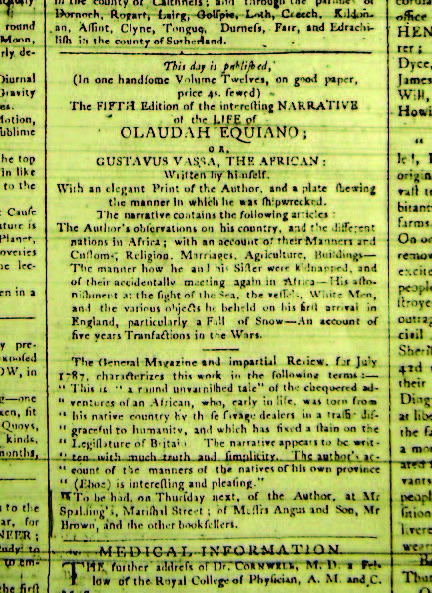
The advertisement placed in the Aberdeen Journal by Olaudah Equiano announcing his visit to Aberdeen on 23 August 1792.
He published his autobiography in 1789 as The Interesting Narrative of the Life of Olaudah Equiano, or Gustavas Vassa the African. The book was a publishing sensation in Britain and, in 1792, when Equiano came to Aberdeen, he was already promoting its fifth edition. He advertised in the Aberdeen Journal telling people they could buy the book from the author himself on 23 August at Mr Spalding’s in Marischal Street.
In his book, Equiano described growing up in Ibo-land in what is now Nigeria, and included a graphic account of being kidnapped in a slaving raid when he was out playing with his sister. Later marched to the coast, he was sold to European slavers and shipped to the Americas.
In 1754, still only a boy, Equiano was sold to a captain in the Royal Navy. He worked on the captain’s ships throughout the Seven Years War, fighting in many sea battles for the British. He also learned to read and write. Later he was sold to a slaver on the island of Montserrat. Because of his education he was not forced to work in the fields, and by 1766 he had earned £40 from private business to buy his freedom.
As a free man, Equiano took service again with the Royal Navy, before settling in London in about 1774. Here he met the anti-slavery campaigner Granville Sharpe and also converted to Christianity. At this stage, however, although he had experienced slavery himself, he did not regard the whole system of slavery as wrong. In 1775, he even joined a scheme to found a British colony in Central America using enslaved labourers from Africa. Here, perhaps he felt the real force of European prejudice against Africans. Although he was legally a free man, a greedy slaver seized him and tried to re-enslave him. Escaping by the skin of his teeth, Equiano returned to the relative safety of London.
In 1786 Equiano was employed by the Navy Board to provision ships for a venture to resettle London’s poor and destitute African population in a new colony in Sierra Leone. He was dismissed when he complained about corruption in the provisioning, and then turned to writing his life story. The book was well-timed. It appeared at the height of the first big campaign against the slave trade, and Equiano used the book to argue passionately against slavery. The book raised enough money for him to devote much of his remaining life to this cause. It also gave him the money to care for a family. In 1792 he married Susanna Cullen of Soham in Cambridgeshire, with whom he had two daughters. He died in London in 1797, but his place of burial remains unknown.
In 1999 the American scholar Vincent Carretta uncovered historical documents showing that as a child and young man Equiano said that his birthplace was Carolina in America, not Africa. This seemed to indicate that he had not been born in Africa and had not been kidnapped there or experienced the ‘middle passage’ as he described in his book.
People have argued ever since about what this means. Was Equiano really born in Africa, and did he simply have a good reason for lying about it when young? Was there perhaps a linguistic or cultural misunderstanding when officials asked him where he came from? Or, was he really born in Carolina, and did he choose to use other Africans’ accounts of kidnapping and enslavement to strengthen the anti-slavery message of his autobiography?
We may never know the answers to these questions. What is clear, however, is that when Equiano wrote his book, he saw himself as an African and took pride in that identity. He used his book not only to argue against slavery, but also to show Europeans what an African could achieve in their world even when confronted by repeated misfortunes and prejudices.



